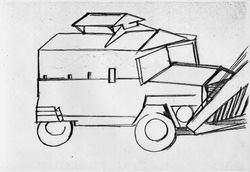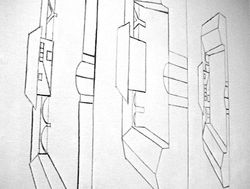1. When Bulldozer כשדחפור
2. Blotted Out Hooligans חוליגנים מחוקים
3. Maminka מאמינקה
4. Hebron - Gola-Goola חברון - גולה-גלה
5. Stone אבן
6. Lady of Kinnereth הגברת מכנרת
7. Star כוכב
1997 - ORIEL 31, Newtown Wales, Feb.15 FIT TO STAND THE GAZE OF MILLIONS
room installation
Curators: Elaine Marshall, Michael Nixon
1997 - U.W.I.C Howard Gardens Gallery, Cardiff, Ap. FIT TO STAND THE GAZE OF MILLIONS, version 2 room installation
Curator: Walt Warrilow.
1997 - ORIEL 31, Newtown Wales, Feb.15 FIT TO STAND THE GAZE OF MILLIONS
room installation
Curators: Elaine Marshall, Michael Nixon
1997 - U.W.I.C Howard Gardens Gallery, Cardiff, Ap. FIT TO STAND THE GAZE OF MILLIONS, version 2 room installation
Curator: Walt Warrilow.
1997 - ORIEL 31, Newtown Wales, Feb.15 FIT TO STAND THE GAZE OF MILLIONS
room installation
Curators: Elaine Marshall, Michael Nixon
1997 - U.W.I.C Howard Gardens Gallery, Cardiff, Ap. FIT TO STAND THE GAZE OF MILLIONS, version 2 room installation
Curator: Walt Warrilow.
1997 - ORIEL 31, Newtown Wales, Feb.15 FIT TO STAND THE GAZE OF MILLIONS
room installation
Curators: Elaine Marshall, Michael Nixon
1997 - U.W.I.C Howard Gardens Gallery, Cardiff, Ap. FIT TO STAND THE GAZE OF MILLIONS, version 2 room installation
Curator: Walt Warrilow.
1997 - ORIEL 31, Newtown Wales, Feb.15 FIT TO STAND THE GAZE OF MILLIONS
room installation
Curators: Elaine Marshall, Michael Nixon
1997 - U.W.I.C Howard Gardens Gallery, Cardiff, Ap. FIT TO STAND THE GAZE OF MILLIONS, version 2 room installation
Curator: Walt Warrilow.
1997 - ORIEL 31, Newtown Wales, Feb.15 FIT TO STAND THE GAZE OF MILLIONS
room installation
Curators: Elaine Marshall, Michael Nixon
1997 - U.W.I.C Howard Gardens Gallery, Cardiff, Ap. FIT TO STAND THE GAZE OF MILLIONS, version 2 room installation
Curator: Walt Warrilow.
Perhaps it is no coincidence that the horse's tail is also used for making paintbrushes Avi Lubin, October 2017
Tamar Getter
TEL HAI YARD IN TWO TOWERS 1975
The Bili Rose Pavillion 1975 Israel Museum, Jerusalem
and the remake in 1998 in the Tel Aviv Museum of Art
The name Tel-Hai cycle refers to several groups of drawings, collages, and paintings made between the end of 1974 and 1978.
The works assembled for the first solo exhibition at the Gilat Gallery, Jerusalem 1975, joined a preoccupation with Tel-Hai (place, building, and historical battle of Tel Hai in 1920) with issues concerning terror. It centered on the name of the Japanese terrorist and PLO supporter, Kozo Okamoto, sentenced to life in prison after the massacre he had committed in the Lod-Airport in 1972.
The wall-drawing Towers of Tel-Hai Yard was made in December that same year at the Bili Rose Pavilion of the Israel Museum in Jerusalem. It participated in the Open Work Shop group show organized by artist Serge Spitzer and curator Yona Fisher.
Along two adjacent walls, there were charcoal variations of the scheme of the Tel-Hai yard. On the one wall in a vertical manner, the yards, pagoda-like, set a floor to ceiling one on top of the other, and a row of larger yards, all rotated on their side, was stretched horizontally on the other wall.
The attempt was to render the geometrical scheme free hand. This means: to let the human body confront in a bodily sense the strict formal symmetry of the scheme.
This wall piece, The Towers of Tel-Hai Yard, was remade on a new scale, fitting the space of the Tel-Aviv Museum of Art in 1998. The occasion was a retrospective of the '70s Art in Israel, curated by Prof. Mordechai Omer and Ellen Ginton.
At large, the Tel-Hai cycle is inherently a drawing cycle. None of the works in this cycle is spontaneous. They are all based on tracing of projected transparencies made from drawings done prior on paper, themselves infra-thinly revised. It occurs through manual recopying of the images from page to page, from one transparency to another, and from ‘towers’ of transparencies put one on top of the other in different orders, revealing each new nuances. Processing an image through such a manual reproduction mode often involves the back and forth change from positive to negative, from pencil or charcoal on bright support to use of chalk or corrective white liquid on black or dark green colored papers.
This way of building up the images of the cycle; Filtering, transcription, revision, control, and repetition are both a work procedure and a thematic issue in the Tel-Hai cycle. It is the very idea of the cycle, an approach to the name: TEL HAI, meaning literally - a living ruin (mound).
השם הכולל מחזור תל-חי מתייחס אל כמה חטיבות של רישומים, קולאז'ים וציורים, שנוצרו בין סוף 1974 ל-1978. העבודות שקובצו ב- ב1975 בתערוכת יחיד ראשונה בגלריה גילת בירושלים, קשרו את העיסוק בתל-חי עם עיסוק בטרור. במרכז התערוכה עמד שמו של הטרוריסט היפני תומך אש"ף קוזו אוקמוטו, שב1972- ביצע טבח בנמל התעופה לוד ונשפט בישראל למאסר עולם.
בדצמבר 1975 בוצע תרשים הקיר חצר תל-חי (ערוכה בשני מגדלים) בתערוכה הקבוצתית "סדנה פתוחה", שאצרו סרז' שפיצר ויונה פישר בביתן בילי רוז במוזיאון ישראל, ירושלים. וריאציות על סקיצות של מיתאר חצר תל-חי בוצעו בפחם על שני קירות ניצבים זה לזה. על קיר אחד נרשמו במאונך חצר על גבי חצר, בתבנית דמויית פגודה, מן הרצפה עד לתקרה - ופעם נוספת נרשמו החצרות מהופכות על צדן ומוגדלות, לכל רוחבו של הקיר השני. היה זה ניסיון להתוות ביד חופשית קווים ישרים ככל האפשר, על גבי הקרנה של תרשימים שבוצעו בעזרת מכשירי שרטוט.
במסגרת תערוכה מקיפה על אמנות ישראלית בשנות ה70-, שאצרו מרדכי עומר ואלן גינתון במוזיאון תל-אביב ב- 1998, שוחזרה העבודה ברוח העיקרון החללי של ביתן בילי רוז, תוך התאמה לתנאי החלל החדשים.
חלקים אחרים של המחזור - עבודות קולאז', עבודות בצילום שחור-לבן ובמכונת העתקה, תרשימי גיר ועטי סימון על נייר, דיקט, עץ, יריעות פוליאתילן ופלסטיק ואחר כך גם עבודות על בדים לא מתוחים - הוצגו באותה תקופה במקומות אחדים בתל-אביב, ביניהם גלריה רוס, גלריה שנער, בית האמנים ומועדון צוותא. הן עסקו בחצר תל-חי, חצר חולדה, בית משטרת נבי-יושע ומבצר אנטיפטריס, בפעולות הטרור שהיו בלוד ובמלון סבוי בתל-אביב, ובטקס הענקת אותות הגבורה לגיבורי מלחמת ששת הימים.
ב1978- אצר יונה פישר את תערוכת היחיד "מחזור תל-חי" במוזיאון ישראל. בעבודות החדשות פותחו כמה מן הנושאים הקודמים ונוספו עליהם חדשים. במרכז התערוכה עמד טיפול משולב בסכימה של מבנה חצר תל-חי ובסכימות של גוף אדם בתבניות טורסו, ראש ודחליל.
על אף שימוש רב שנעשה בצילום - תמיד צילום מיד שנייה, מטלוויזיה, מעיתונות ומספרים - מחזור תל-חי הוא ביסודו מחזור רישום. ציורי המחזור, כמו הרישומים, מבוססים על סימון, העתקה ו/או הקרנה של שקפים. כל העבודות נוצרו תחילה על נייר.
עבודת הרישום התגבשה בשינויים דקים, בהעתקות ידניות חוזרות ונשנות של הדימויים מנייר לנייר, משקף לשקף, וב"מגדלי" שקפים שהונחו בחבילה זה על גבי זה. התהליך עירב מעברים הלוך-ושוב מפוזיטיב לנגטיב, גם בחומרי הרישום וגם במצעיו. הרלוונטיות הנמוכה של ה"מקור" בנוהל עבודה כזה מדגישה את החיפוש אחר קווי המיתאר ואת החזרה המרובה כמושגי המפתח (פורמליים ותימטיים) של המחזור.
רוב הסקיצות הוכתמו והושחתו על רצפת הסטודיו. רק בשלב מאוחר יותר, בעצת ידיד, לוקטו וצולמו במכונת העתקה כמאה מהן. רפרודוקציות אלה נאספו בתיק שהיה לדוקומנט המרכזי של סקיצות תל-חי. שני פרקים חלקיים מהתיק הזה, ה"חצרות" וה"טורסו", נבחרו ללוות ספר זה. המתודה והתימות שעובדו בסקיצות תל-חי מצויות בעיבוד מתמיד ומשוקעות ברוב קבוצות הציורים שנעשו מ1980- ואילך.
each
 |  |  |
|---|---|---|
 |  |  |
 |  |  |
 |  |  |
 |  |  |
 |  |  |
 |  |  |
 |  |  |
 |  |  |
 |  |  |
 |  |  |
 |  |  |
 |  |